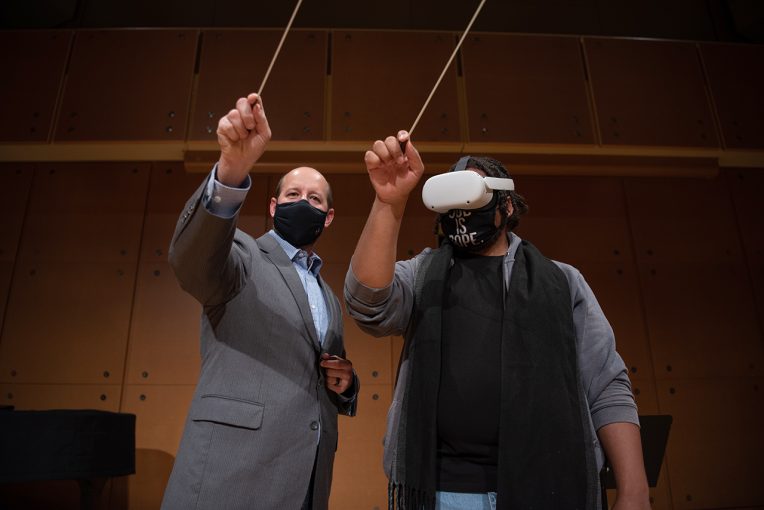In 2018 Dr. Roy D. Magnuson completed a user-friendly version of solsticeVR, a virtual reality tool that enables users to compose music. While his work on the “musical sandbox” proved to be a success, just one year later, the development of a virtual reality conducting tool began.
Magnuson, the associate director of the Creative Technologies Program and associate professor of music composition, brought this idea to Dr. Tony Marinello, director of Bands and assistant professor of music, and Dr. Tim Fredstrom, professor of choral music education. The trio immediately realized the impact that such a program could have on the way their intermediate conducting course is taught. So began work on RibbonsVR.
“Our team is a really unique thing in that we have a technology genius in Roy, a conducting genius in Tony, and I may know a little bit about pedagogy,” Fredstrom said. “And so as a result we have a synergy among the three of us.”
“We found this combination of three people who all speak the same language about conducting, and are all musicians, but then also the other commonality is that all three of us have a deep commitment to education,” Marinello said, “I mean Tim and Roy, are two of the best teachers that I know. And that’s the coolest part is, not only do we understand this musician side of it, but we are also very committed to education and each of us brings a different part of how to create good quality music education.”
RibbonsVR focuses on the conducting aspect of creating music. The program, originally funded through a Center for Teaching, Learning, and Technology Teaching Innovation grant in 2019, allows users to see visual representations of their conducting in real time, as the technology reacts to their arm movements. Marinello compared the visual to drawing shapes in the air with a sparkler firework. When applied to the course, students can see their patterns and recognize where corrections should be made.
The program was formally introduced in class this semester and has completely transformed the way the course is taught. In the past the two professors would start the course with an overview of the physical dimensions of conducting, such as hand position and patterns; transition into timing; and then jump into application, cleaning up technique along the way. Now their method starts with a focus on developing the habits students will need in live conducting earlier in the course.
“Typically we’ve always taught things like, ‘Here’s the finished product; go replicate it. OK, you did all these things wrong, let’s go back and fix it,’ as opposed to just starting with one basic thing. Now we add sequentially one skill at a time, and we keep doing that so we’re ingraining those good habits,” Marinello said.
Fredstrom finds this method to be more effective, as developing student skill in this way ensures that they will have the ability to apply what they learn.
“We had to do a lot of reteaching in the traditional program. Now we don’t,” Fredstrom said. “In this model we are really teaching with the big idea, and teaching for transfer, which I think also makes us really unique.”
The music in the user’s headset will speed up and slow in time with the conductor’s movements, mimicking a live conducting experience in a way that typical recorded practice sessions cannot.
“It engineers the human experience of conducting without having actual humans in front of you. It’s super weird, but it’s super cool,” said Grace Reuter, a senior music education major and mathematics minor from Freeburg who takes Marinello’s intermediate instrumental conducting course.
Reuter also appreciates that the students have the opportunity to be directly involved in the progression of the program.
“We go through the conducting rounds, and at the very end, when we’re doing reflections, we’ll take this survey to say, ‘OK, this was our experience with the VR this round,’” Reuter said.

The survey asks students to share their thoughts on what the program offers. Questions ask them to reflect on their experiences with the program, identify strengths in its application to their education, and highlight any areas that could use improvement. The survey includes a note from the three professors: “We are genuinely curious about your opinion.”
Magnuson, Fredstrom, and Marinello plan to release the technology to be used at other institutions by August 2022. The professors are excited to see how the technology and teaching within the course will continue to build off each other as the tool continues to evolve.
“To think of how far this has come, I think trying to put definite outcomes and definite destinations could in some ways be dangerous,” Marinello said. “(Using the program) really does work in a feedback loop where sometimes the technology is pushing us to go somewhere pedagogically and then sometimes the pedagogy is pushing us to go somewhere technologically.”
“The future is based in this concurrent realization of what does a pedagogy, or a method of instruction look like, and what can the technology do as it evolves,” Fredstrom said. “This type of approach is not just like writing a book and putting it on the library shelf. It is an ever-evolving creative process.”

